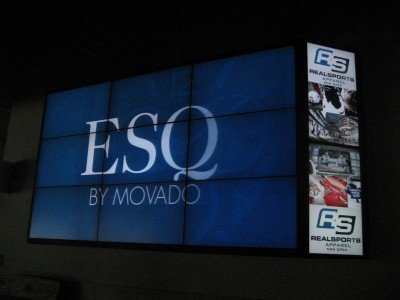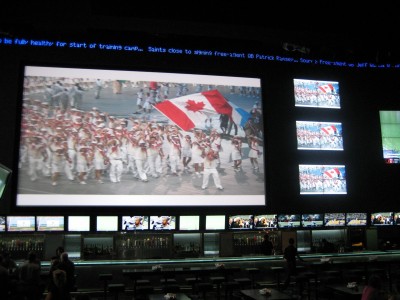Measuring the impact of digital signage requires a combination of several metrics:
- Presence—The number of viewers in the area where the display is visible and, if appropriate, audible.
- Notice—Evidence that the viewers are actually noticing the display, through anonymous detection software.
- Dwell time—How long the viewers spend in the display area.
New audience-detection hardware and software have made all of these metrics possible, collecting continuous data about the audience for digital signage.

 Maple Leaf Sports & Entertainment’s (MLSE’s) digital signage team recently configured screens throughout the Real Sports Grill, reportedly the largest sports bar anywhere in North America, which sits adjacent to the Air Canada Centre in downtown Toronto.
Maple Leaf Sports & Entertainment’s (MLSE’s) digital signage team recently configured screens throughout the Real Sports Grill, reportedly the largest sports bar anywhere in North America, which sits adjacent to the Air Canada Centre in downtown Toronto.
The players
Many audiovisual (AV) and information technology (IT) integrators, who already understand visual communications, are embracing the current generation of digital signage technologies. In some cases, their traditional business has been hurt by a declining market for digital projectors and other more typical AV products. In other cases, the motivation to switch gears comes from seeing some of their existing customers—in corporate communications, hospitality, food services, health care, retail and other sectors—adopt digital signage without their involvement.
“Dynamic signage investments are no longer considered optional or extravagant, but a requirement to meet expectations,” says Mike White, president of Multi-Media Solutions, a commercial display system integrator.
Some of the most recent players in the digital signage industry are traditional signmaking and wide-format printing companies, with some static signs being swapped out for dynamic displays.
“We’ve had success working with the sign business,” says Dave Spence, VP of business development for Coxcom, a digital signage installation company based in Mississauga, Ont. “Small networks have proven viable.”
Given the traditional sign and graphics industry generates an estimated $47 billion in North America, twice the size of the AV and IT integration market, there is a significant opportunity for technology suppliers and integrators to benefit from signmakers’ established content creation community and customer base.
Architects and other designers of built spaces are expected to be the next to come on board. They also represent a tremendous opportunity, as they can help plan contextually relevant environments for digital signage.
Lyle Bunn is a digital signage analyst, consultant, educator and adviser based in Brighton, Ont. For more information, visit www.lylebunn.com.





